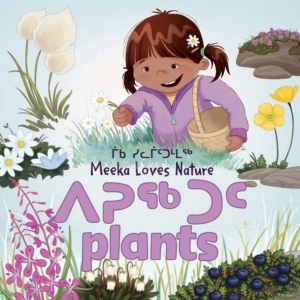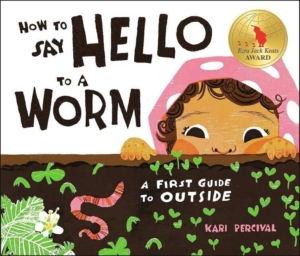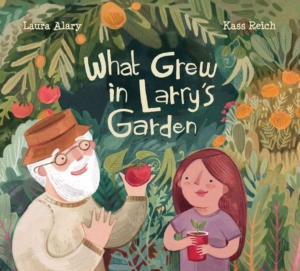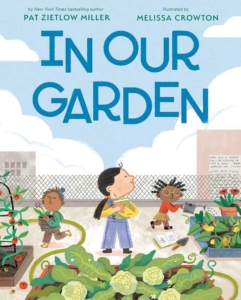Books we would love to have in our Library

Garden Wonders (Sarah Grindler)
Whether you have a big backyard or pots on a balcony, you can grow just about anything if you have healthy soil, plenty of water, and bright sunlight. This book takes young readers through every step to creating their own garden: from collecting nutrient-rich soil and choosing the right time of day to water your plants, to identifying helpful critters from unwanted pests. Featuring new vocabulary words like "germinate," "fertilizer," and "pollinator," and encouraging a microscopic look at nature, this is the perfect book for curious little gardeners.

Lessons From Mother Earth (Elaine McLeod & Colleen Wood)
Tess has visited her grandmother many times without really being aware of the garden. But today they step outside the door and Tess learns that all of nature can be a garden. And if you take care of the plants that are growing, if you learn about them -- understanding when they flower, when they give fruit, and when to leave them alone -- you will always find something to nourish you. This gentle story demonstrates the First Nations' tradition of taking care of Mother Earth.

Fall Leaves (Loretta Holland & Elly MacKay)
Part poem, part silent stage, this luminous picture book puts autumn on display and captures the spirit of change that stays with us long after fall leaves. Unlock the secrets of this busy and beautiful time of year as the natural world makes way for winter.

Herbaria: A Guide For Young People (Kelly LaFarge)
What good is a dead plant? A lot! Herbaria explains why, leading readers on an accessible, engaging exploration of who loves dead plants—and why. In these pages, we learn about famous historical plant collectors and the paths they established investigating plants. Readers join today's field botanists as they go far and wide to discover new species, and we get to look in the herbarium at how specimens are mounted and organized for everyone to use and enjoy. The book as a whole helps kids to visualize themselves as botanists gathering, preserving, and unlocking the mysteries of plants. In addition to beautiful watercolor illustrations and photos, the book includes interactive features such as lift-a-flaps, overlays, and a foldout.

The Hike (Alison Farrell)
A plucky and sweet adventure story, The Hike celebrates how fun and rewarding it is to explore nature in your own backyard. Three intrepid young explorers set out to conquer the outdoors in their local forest, enjoying the process in their own different ways. Wren brings a sketchbook and a flag, El brings a poetry notebook, and Hattie brings feathers. They get lost and use maps to find their way. They draw wildlife, spot deer tracks, and see a deer before it startles and disappears, all before they finally and joyfully reach their destination.

At The Pond (Werner Zimmermann)
Spend a lazy summer day exploring a tiny, perfect slice of nature. Count goldfish as they swim about the tranquil pond. Watch as sunlight moves across the water. Spot a water lily blossoming, frogs and water striders hopping through, a heron flying by. With a simple text and rich, lifelike paintings, Werner Zimmermann has created a peaceful meditation on nature and a unique and beautiful world for readers of all ages to enjoy.
Continue the learning journey at the end of the book, where you'll find more information on all the animals that call the pond home.

Under Your Feet (Wenjia Tang)
Under Your Feet delves beneath the Earth's surface and explores the diverse wonders hidden there. Encounter creatures of the deep and marvel at the mind-boggling size of the humongous fungus - the biggest organism in the world. Learn how one handful of ordinary soil contains more organisms than there are people on Earth, and carry out experiments using dirt from your own back garden.
Under Your Feet offers you the opportunity to expand your knowledge of the natural world and soil-dwelling creatures big and small.

Baby Botanist (Dr. Laura Gehl & Daniel Wiseman)
Baby Botanist studies plants. In her lab coat, she looks at plants both large and small. She finds plants growing in many places.
Can plants grow on water?
What foods come from plants?
Find out with Baby Botanist.

What Linnaeus Saw (Karen Magnuson Beil)
In What Linnaeus Saw, Karen Magnuson Beil chronicles Linnaeus's life and career in readable, relatable prose. Linnaeus was an avid student of the natural world and explored the school's gardens and woods, transfixed by the properties of different plants. At twenty-five, on a solo expedition to the Scandinavian Mountains, Linnaeus documented and described dozens of new species. As a medical student in Holland, he moved among leading scientific thinkers and had access to the best collections of plants and animals in Europe. What Linnaeus found was a world with no consistent system for describing and naming living things—a situation he methodically set about changing. The Linnaean system for classifying plants and animals, developed and refined over the course of his life, is the foundation of modern scientific taxonomy, and inspired and guided generations of scientists.

The Wall and the Wild (Christina Dendy & Kate Rewse)
When Ana tries to take control by creating a perfect garden, she comes to realize that nature is inherently wild.
In a plot of land at the edge of town, Ana grows only perfectly sized plants and perfect-looking flowers; she throws all the irregular shoots and uneven seeds over the wall into the disorderly Wild. But as her garden gets tidier, neater and more constrained, the Wild begins to grow…

Plantopedia (Adrienne Barman)
Filled with fascinating flowers, curious crops, and wonderful weeds, this book will keep young explorers busy for hours. Alphabetically ordered by their special traits and characteristics, including:
• The big eaters – meet the insect-digesting plants, such as the Venus flytrap
• The confused fruits – avocado, tomato, eggplant, and more you thought were veggies
• The giants – admire among them the elephant cactus, which grows up to 50 feet tall
• The guests – with parasites such as mistletoe, which sucks nutrients from trees
• The healers – a collection of medicinal plants, such as echinacea, tea tree, and chamomile
• The old-timers – featuring the giant sequoia, which can live for over 3,000 years

Be a Tree! (Maria Gianferrari & Felicita Sala)
We are all like trees: our spines, trunks; our skin, bark; our hearts giving us strength and support, like heartwood. We are fueled by air and sun.
And, like humans, trees are social. They “talk” to spread information; they share food and resources. They shelter and take care of one another. They are stronger together.
In this gorgeous and poetic celebration of one of nature's greatest creations, acclaimed author Maria Gianferrari and illustrator Felicita Sala both compare us to the beauty and majesty of trees—and gently share the ways in which trees can inspire us to be better people.

When Plants Attack (Rebecc E.Hirsch)
Science writer and plant expert Rebecca E. Hirsch presents fun and gross facts about a variety of plants along with explaining the science behind why they do what they do. Featured plants include the Venus Flytrap, an African tree that houses stinking ants to protect itself from hungry animals, a "vampire vine" that sucks nutrients from other plants, and fiendishly invasive kudzu. Ages 9-14

My First Book of Growing Food (Duopress Labs & Asa Gilland)
My First Book of Growing Food is a beautiful introduction for babies and toddlers to the benefits of growing food, helping them to develop a connection with the natural world.
Simple and quirky text pairs with charming art in this book where future nature lovers will learn about growing simple foods in a friendly and easy way while being introduced to basic concepts of the environment.
Tots will learn that lettuce and tomatoes are easy to grow; herbs like rosemary, mint, and cilantro grow happily next to a bright window; and yes, tots can grow their own strawberries.

Nature Out Of Balance (Merrie-Ellen Wilcox)
Invasive species threaten local ecosystems and the planet's biodiversity, but are they all as bad as we think they are?
Plants, animals, insects and fish are moving in. In Nature Out of Balance:How Invasive Species Are Changing the Planet author Merrie-Ellen Wilcox profiles all-star invasive species around the world, starting in her own neighbourhood, and warns that humans are the most invasive species of all. We find out how and why species become invasive, what we can do to stop their spread and whether it's time to think differently about invasive species that are here to stay.

Meeka Loves Nature: Plants (Danny Christopher & Ali Hinch)
There are so many plants to discover in the North. Join Meeka as she explores the tundra to find all sorts of plants, from Arctic cotton to purple saxifrage and everything in between.

Benjamin's Thunderstorm (Melanie Florence & Hawlii Pachette)
Benjamin loves the rain. He loves splashing through puddles in his bright yellow rain boots and watching the colors of a rainbow in the water as they ripple around his feet. But most of all, Benjamin loves thunder. To him, thunder — piyêsiwak — sounds like his grandfather's drum. It calls to him, like the songs his grandfather plays while his father and other powwow dancers spin and step in time to the drumbeat. As Benjamin hears the thunder rumble overhead, he imagines himself as a powwow dancer. He spins, he taps his feet and he lifts his knees. Faster and faster he twirls, delighted by and filled with the rhythm of piyêsiwak.

How to Say Hello to a Worm (Kari Percival)
The beautiful simplicity of a garden is depicted through digital woodcut illustrations and engaging nonfiction text presented as a series of sweet questions and gentle replies. Less of a traditional how-to and more of a how-to-appreciate, this soothingly sparse text paints an inviting and accessible picture of what a garden offers. And with an all-child cast, the absence of an adult presence empowers readers to view the garden and its creatures through their own eyes, driven by curiosity and wonder.

Summer Green to Autumn Gold (Mia Posada)
This nonfiction picture book beautifully explains why leaves change color in fall. It highlights both the eye-catching colors of the season and the science behind the colors. Back matter offers additional scientific details for curious readers as well as suggested further reading and links to hands-on activities.

Cool Green: Amazing, Remarkable Trees (Lulu Delacre)
As he works with his young granddaughter to nurture a potted sapling, a Latino landscaper shares his love and admiration of trees. From the extraordinary rainbow gum tree to the mighty, towering redwood, each of the thirteen specimens he tells of is a miracle of the natural world—and some are strange beyond the wildest imagining. Brimming with exuberance and color, this ode to trees of the world—and the vast knowledge of landscapers and gardeners—offers a feast for the eyes, with author-illustrator Lulu Delacre paying touching tribute by imbedding seeds, fronds, and leaves within her art.

Gwendolyn's Pet Garden (Anne Renaud & Rashin Kheiriyeh)
Gwendolyn longs for a pet. What kind? Any kind! How many legs? Two, four, ten--she's not picky! But her parents have other ideas, and instead they give her . . . a box of dirt. "It smells of swamp," Gwendolyn says--but her parents say it smells of possibilities. And once Gwendolyn gets savvy about seeds and soil, sun and shade, she finds they are right. The dirt starts performing some amazing tricks, and soon she has a whole pet garden of her very own--it might not have "any legs at all, but it was alive, and Gwendolyn could talk to it, care for it, and watch it grow."

Busy Spring: Nature Wakes Up (Sean Taylor & Alex Morss & Cinyee Chiu)
In this uplifting picture book about spring, follow two children and their father through their backyard as they discover all the different ways nature wakes up from its long winter sleep.
Spot the busy creatures and plants as the tale unfolds, then learn about how each responds to the increasing daylight and warmth that usher in the season.
In each colorful scene, the family discovers a different sign of spring—a bird collecting twigs for its nest, a fox snuggling her cubs, a caterpillar feasting on leaves… After the story, annotated illustrations explain the spring behaviors of various plants and animals.

The Wisdom of Trees (Lita Judge)
With lush illustrations, poems, and accessible scientific information, The Wisdom of Trees by Lita Judge is a fascinating exploration of the hidden communities trees create to strengthen themselves and others.
The story of a tree is a story of community, communication, and cooperation. Although trees may seem like silent, independent organisms, they form a network buzzing with life: they talk, share food, raise their young, and offer protection. Trees thrive on diversity, learn from their ancestors, and give back to their communities. Trees not only sustain life on our planet―they can also teach us important lessons about patience, survival, and teamwork.

Every Color Soup (Jorey Hurley)
Purple, yellow, orange, and red. Just the right mix of colored vegetables make a delicious soup in this tasty introduction to colors, counting, and veggies.
All you need is a pot, a spoon, an adult helper, and vegetables of many colors to make a very special soup—Every Color Soup. Learn colors and vegetable names in this bright and colorful picture book with minimal text perfect for the beginning reader. Jorey Hurley's bright, graphic art and simple text make this vibrant book a perfect read-aloud for budding cooks and their families. This lively picture book also comes with a recipe.

What Grew in Larry's Garden (Laura Alary & Kass Reich)
A girl and her neighbor grow a community from their garden. Grace thinks Larry's garden is one of the wonders of the world. In his tiny backyard next door to hers, Larry grows the most extraordinary vegetables. Grace loves helping him --- watering and weeding, planting and pruning, hoeing and harvesting. And whenever there's a problem --- like bugs burrowing into the carrots or slugs chewing the lettuce --- Grace and Larry solve it together. Grace soon learns that Larry has big plans for the vegetables in his special garden. And when that garden faces its biggest problem yet, Grace follows Larry's example to find the perfect solution.

Soar High, Dragonfly! (Shery Mabry Bestor & Jonny Lambert)
Dragonflies are some the world's most beautiful (and fascinating!) insects. And one many children can find right in their backyards. With a simple story, perfect for read-alouds, and colorful illustrations, this scientific look at a dragonfly's life cycle will captivate little entomologists. Informative sidebars are included that let children learn even more about these amazing insects.

I Ate Sunshine for Breakfast (Michael Holland & Phillip Giordano)
Did you know that the rubber in your shoes came from a tree? Ever wondered where your breakfast cereal is grown? Have you remembered to thank a bee today for the food you ate for dinner last night?
Get ready to learn everything you never knew about plants and then some. This illustrated compendium celebrates the plants you didn't even know you used, from your toothpaste to your car tires to the name of your great-great-aunt. This comprehensive overview also contains great plant projects you and your friends can try at home.

In Our Garden (Pat Zietlow Miller & Melissa Crowton)
Millie has recently moved to a new city, from a place more than an ocean away. More than anything she misses the garden where her family used to grow food. Then one day she has an idea—the school has a fine flat roof, perfect for a garden. Soon her teacher and classmates are on board, but it takes more than ideas to build a garden. It takes supplies and hard work; it takes a lot of learning; and it takes a whole school—a whole community—coming together to help. And of course, it also takes a lot of waiting. But as Millie's teacher Miss Mirales says, “Be patient. Good things take time.”

Spring is for Strawberries (Katherine Pryor & Polina Gortman)
When a farm family brings their spring crops to a city farmers market, the farmer's daughter befriends the daughter of a neighborhood family doing their weekly shopping. Over the course of a year, the girls explore the bounty of each season.
Sweet spring strawberries and crisp, fresh greens make way for corn on the cob, peppers, and a rainbow of tomatoes. Fall brings pumpkin patches and the crunch of apples. The friends part at the final winter market, already looking forward to the sweet red strawberries that will unite them again next spring.